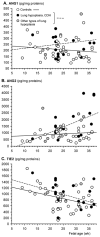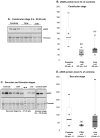Defective angiogenesis in hypoplastic human fetal lungs correlates with nitric oxide synthase deficiency that occurs despite enhanced angiopoietin-2 and VEGF
- PMID: 20348277
- PMCID: PMC3108964
- DOI: 10.1152/ajplung.00333.2009
Defective angiogenesis in hypoplastic human fetal lungs correlates with nitric oxide synthase deficiency that occurs despite enhanced angiopoietin-2 and VEGF
Abstract
Lung hypoplasia (LH) is a life-threatening congenital abnormality with various causes. It involves vascular bed underdevelopment with abnormal arterial muscularization leading to pulmonary hypertension. Because underlying molecular changes are imperfectly known and sometimes controversial, we determined key factors of angiogenesis along intrauterine development, focusing at the angiopoietin (ANG)/Tie-2 system. Lung specimens from medical terminations of pregnancy (9-37 wk) were used, including LH due to congenital diaphragmatic hernia (CDH) or other causes, and nonpulmonary disease samples were used as controls. ELISA determination indicated little ANG-1 change during pregnancy and no effect of LH, whereas Tie-2 declined similarly between 9 and 37 wk in LH and controls. By contrast, ANG-2 markedly increased in LH from 24 wk, whereas it remained stable in controls. Because VEGF increased also, this was interpreted as an attempt to overcome vascular underdevelopment. Hypothesizing that its inefficiency might be due to impaired downstream mechanism, endothelial nitric oxide synthase (eNOS) was determined by semiquantitative Western blot and found to be reduced by approximately 75%, mostly in the instance of CDH. In conclusion, angiogenesis remains defective in hypoplastic lungs despite reactive enhancement of VEGF and ANG-2 production, which could be due, at least in part, to insufficient eNOS expression.
Figures





Similar articles
-
Temporal changes of angiopoietins and Tie2 expression in rat lungs after monocrotaline-induced pulmonary hypertension.Comp Med. 2009 Aug;59(4):350-6. Comp Med. 2009. PMID: 19712575 Free PMC article.
-
Disruption of Ang-1/Tie-2 signaling contributes to the impaired myocardial vascular maturation and angiogenesis in type II diabetic mice.Arterioscler Thromb Vasc Biol. 2008 Sep;28(9):1606-13. doi: 10.1161/ATVBAHA.108.169235. Epub 2008 Jun 12. Arterioscler Thromb Vasc Biol. 2008. PMID: 18556567 Free PMC article.
-
Angiopoietin-1 and VEGF in vascular development and angiogenesis in hypoplastic lungs.Am J Physiol Lung Cell Mol Physiol. 2002 Jul;283(1):L60-6. doi: 10.1152/ajplung.00317.2001. Am J Physiol Lung Cell Mol Physiol. 2002. PMID: 12060561
-
VEGF, angiopoietin-1 and -2 in bronchial asthma: new molecular targets in airway angiogenesis and microvascular remodeling.Recent Pat Inflamm Allergy Drug Discov. 2007 Feb;1(1):1-8. doi: 10.2174/187221307779815066. Recent Pat Inflamm Allergy Drug Discov. 2007. PMID: 19075960 Review.
-
Multiple roles of angiopoietins in atherogenesis.Curr Opin Lipidol. 2011 Oct;22(5):380-5. doi: 10.1097/MOL.0b013e32834b26b3. Curr Opin Lipidol. 2011. PMID: 21881497 Review.
Cited by
-
Expected small left heart size in the presence of congenital diaphragmatic hernia: Fetal values and Z-scores for infants confirmed to have no heart disease postnatally.Front Pediatr. 2022 Dec 6;10:1083370. doi: 10.3389/fped.2022.1083370. eCollection 2022. Front Pediatr. 2022. PMID: 36561485 Free PMC article.
-
Pulmonary hypoplasia associated with congenital heart diseases: a fetal study.PLoS One. 2014 Apr 3;9(4):e93557. doi: 10.1371/journal.pone.0093557. eCollection 2014. PLoS One. 2014. PMID: 24699523 Free PMC article.
-
Effect of corticosteroids and lung ventilation in the VEGF and NO pathways in congenital diaphragmatic hernia in rats.Pediatr Surg Int. 2014 Dec;30(12):1207-15. doi: 10.1007/s00383-014-3610-y. Epub 2014 Oct 15. Pediatr Surg Int. 2014. PMID: 25316436
-
The role of gasotransmitters in neonatal physiology.Nitric Oxide. 2020 Feb 1;95:29-44. doi: 10.1016/j.niox.2019.12.002. Epub 2019 Dec 20. Nitric Oxide. 2020. PMID: 31870965 Free PMC article. Review.
-
ANG-1 TIE-2 and BMPR signalling defects are not seen in the nitrofen model of pulmonary hypertension and congenital diaphragmatic hernia.PLoS One. 2012;7(4):e35364. doi: 10.1371/journal.pone.0035364. Epub 2012 Apr 23. PLoS One. 2012. PMID: 22539968 Free PMC article.
References
-
- Ahmed A, Fujisawa T, Niu XL, Ahmad S, Al-Ani B, Chudasama K, Abbas A, Potluri R, Bhandari V, Findley CM, Lam GK, Huang J, Hewett PW, Cudmore M, Kontos CD. Angiopoietin-2 confers Atheroprotection in apoE−/− mice by inhibiting LDL oxidation via nitric oxide. Circ Res. 2009;104:1333–1336. - PMC - PubMed
-
- Akeson AL, Greenberg JM, Cameron JE, Thompson FY, Brooks SK, Wiginton D, Whitsett JA. Temporal and spatial regulation of VEGF-A controls vascular patterning in the embryonic lung. Dev Biol. 2003;264:443–455. - PubMed
Publication types
MeSH terms
Substances
LinkOut - more resources
Full Text Sources
Miscellaneous

